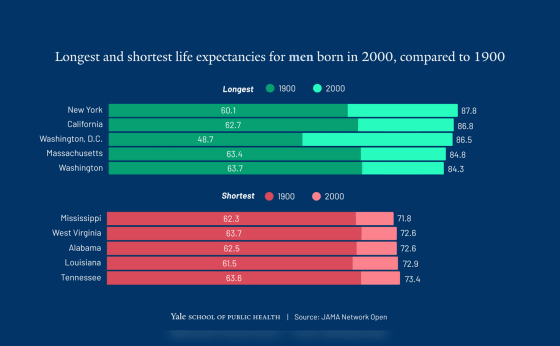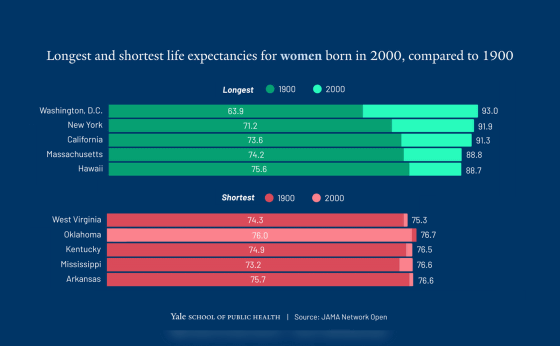In some U.S. states, female life expectancy has remained almost constant for a century

The United States is known for its poor health, with research showing that
All-Cause Mortality and Life Expectancy by Birth Cohort Across US States | Public Health | JAMA Network Open | JAMA Network
https://jamanetwork.com/journals/jamanetworkopen/fullarticle/2833159

Study Reveals Stark Differences in Life Expectancy Across US States Over the Past Century < Yale School of Public Health
https://ysph.yale.edu/news-article/study-reveals-stark-differences-in-life-expectancy-across-us-states-over-the-past-century/
Life Expectancy Has Barely Changed in Some US States For More Than a Century : ScienceAlert
https://www.sciencealert.com/life-expectancy-has-barely-changed-in-some-us-states-for-more-than-a-century
A large-scale study led by the Yale School of Public Health analyzed data on 179 million deaths in the United States between 1969 and 2020 and looked at the average life expectancy for each birth cohort. They then estimated how much life expectancy changed in each state from people born in 1900 to people born in 2000.
'Looking at mortality trends by birth cohort more accurately reflects the lived experiences of a population. It shows the long-term effects of policies and social conditions that affect a population's lives - effects that might not be visible when comparing mortality rates across different generations year by year,' said Dr. Theodore Holford, lead author of the paper and professor of biostatistics at the Yale School of Public Health.

The analysis found that life expectancy increased across the board for the 2000 birth cohort compared to those born in 1900, but the extent of the increase varied widely across states. States in the Northeast and West saw the largest increases in life expectancy, while southern states saw only small increases, with some states reporting little change over the past century.
The graph below compares the average life expectancy of men born in 1900 and those born in 2000 for the 'five states with the longest/shortest life expectancy of men born in 2000'. In

For women, the disparity is even more pronounced. The graph below compares the life expectancy of those born in 1900 and 2000 for the 'five states with the longest and shortest life expectancies for women born in 2000.' The states with the longest life expectancies for women born in 2000 are Washington DC, New York, California, Massachusetts, and

'Life expectancy for women born in some southern states increased by less than three years between 1900 and 2000,' Holford said. 'This is a striking contrast when you consider that in states like New York and California, life expectancy increased by more than 20 years over the same period.'
The research team also investigated the 'rate of increase in mortality after age 35.' The results show that the faster the rate of increase in mortality, the greater the negative effects of aging, and the slower the rate of increase, the healthier the aging. Regional differences were also clear in this study, with the increase in mortality slower in New York and Florida , while the increase in mortality was faster in Oklahoma and Iowa .
Commenting on these patterns, Holford said, 'The disparities we see today are the result of decades of cumulative effects of smoking rates, access to health care, environmental exposures, and investments in public health. Without conscious policy change, these gaps will likely persist or even widen.'
'For example, it's not surprising that states with less improvement in life expectancy have higher poverty rates,' said Dr. Jamie Tam , co-author of the study and assistant professor of health policy at the Yale School of Public Health. 'Trends in mortality and life expectancy also reflect underlying demographics. The benefits of health interventions last a lifetime. Not acting early and investing in public health harms future generations.'
Related Posts:
in Science, Posted by log1h_ik







